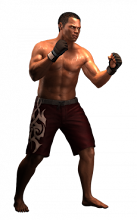All boxers, regardless of their weight class, have certain kinds of clothing that are essential for bouts. Professional boxers wear different clothes from amateur ones but there is a basic idea or sense in them. All boxers in sanctioned fights are required to have handwraps, gloves, groin protectors, mouth guards and soft soled shoes.
Boxing Shorts
In amateur boxing, each boxer wears shorts approved by the sanctioning body in the color of their corner. In professional boxing, the color and design of the shorts is left up to each fighter and is not regulated. Many types of shorts are striped with bright colours. Many boxers have their name or nickname embroidered on the waistband of the shorts, along with sponsor logos and even the sanctioning bodies which have awarded them belts. Many boxers, such as Prince Naseem Hamed, have very elaborate shorts, while others such as Mike Tyson prefer plain ones. Shorts in the modern era are much looser fitting than those of previous generations for improved movement, comfort and style.
 |
| Prince Naseem |
 |
| Mike Tyson |
Boxing Tank tops
Amateur boxers wear tank top shirts, as do female professional boxers. Some female boxers choose to wear sports bras rather than tank tops. Upper body cover varies from boxer to boxer due to preference. Professional male boxers always compete bare-chested, i.e. without any upper-body clothing.
 |
| Female Boxer - Laila Ali |
Boxing Protective equipment
Amateur boxers are required to have headgear and a sleeveless shirt in the color of their corner, while professionals fight bare-chested and without headgear. Female boxers in amateur ranks are allowed a short sleeved shirt, where as professionals wear a sleeveless shirt. All female boxers are allowed a chest protector. All boxers are required a mouthpiece, the construction of which is up to the sanctioning body and the fighters. All boxers in sanctioned bouts are required to have a foul protector, which protects the groin and lower abdomen. Female foul protectors have less padding in the groin, but are still required in sanctioned bouts. All boxers also wear gloves, ranging in weight from 8-16oz in amateur bouts and 6-12oz in professional bouts. Amateurs are bound by an approved glove, whereas professional boxers have only a minimum weight of glove, the exact weight and even brand can be determined in the negotiations prior to the fight. Gloves are subject to inspection both by the representatives of the sanctioning body and the opposing fighter's corner prior to a fight. They are then taped on the laces to prevent them from coming loose, and are usually signed by the representative of the sanctioning body to assure no tampering has taken place. Boxers are also required to have handwraps. USA Boxing allows re-usable cotton handwraps with a hook and loop closure, whereas most professional fights require adhesive, one time use wraps. Wraps are also subject to inspection, a notable example being the fight between Shane Mosley and Antonio Margarito, where a plaster like substance was found in the wraps of Margarito, resulting in his suspension for "at least a year." In modern-day professional boxing, it is mandatory for males to wear a waistband wrapped around their upper thighs and the lower waist. This waistband is usually black or red and is made of rubber (sometimes leather) in order to cushion the body from deadly shots towards the male's most vulnerable body part—the pelvis. However, it is still possible to suffer from a blow to the pelvis despite having the waistband; depending on the strength of the punch. The waistband gets bent and twisted during fights and often sticks out of the boxer's shorts which causes the boxer's belly to be slightly squeezed. Before the 1980s, the waistband was much smaller and therefore; allows more damage onto the boxer's pelvis.
Boxing Footwear
All boxers are required to have soft soled shoes, which minimizes the damage from accidental or intentional stepping on feet. The construction of the shoe is up to the fighter, with many inside fighters preferring textured rubber soles for increased traction, and many outside fighters preferring smooth soles for decreased friction and easier movement.
Boxing Equipment
Since boxing involves forceful, repetitive punching, precautions must be taken to prevent damage to bones in the hand. Most trainers do not allow boxers to train and spar without hand/wrist wraps and boxing gloves. Hand wraps are used to secure the bones in the hand, and the gloves are used to protect the hands from blunt injury, allowing boxers to throw punches with more force than if they did not utilize them. Gloves have been required in competition since the late nineteenth century, though modern boxing gloves are much heavier than those worn by early twentieth-century fighters. Prior to a bout, both boxers agree upon the weight of gloves to be used in the bout, with the understanding that lighter gloves allow heavy punchers to inflict more damage. The brand of gloves can also affect the impact of punches, so this too is usually stipulated before a bout. A mouth guard is important to protect the teeth and gums from injury, and to cushion the jaw, resulting in a decreased chance of knockout.
Boxers practice their skills on two basic types of punching bags. A small, tear-drop-shaped "speed bag" is used to hone reflexes and repetitive punching skills, while a large cylindrical "heavy bag" filled with sand, a synthetic substitute, or water is used to practice power punching and body blows. In addition to these distinctive pieces of equipment, boxers also utilize more general use training equipment to build strength, speed, and agility. Common training equipment includes free weights, rowing machines, jump rope, and medicine balls.
Source: http://en.wikipedia.org/wiki/Boxing
MMA Pro Fighter










































